Blog
Surgery for Big-Toe Bone Spurs

Surgery for big toe bone spurs is designed to ease pain and restore movement when extra bone around the big toe joint limits motion and causes ongoing discomfort. A podiatrist can examine the joint to determine if a procedure called a cheilectomy is appropriate. During this big-toe surgery, the podiatrist removes excess bone from the MTP, or metatarsophalangeal joint, which allows the big toe to bend. These bone spurs often form from arthritis, repeated stress, or long-standing stiffness known as hallux rigidus. Clearing the extra bone creates more room for the toe to move and helps reduce irritation when walking or pushing off the ground. In some cases, the podiatrist may smooth areas where cartilage has worn down to support better joint function. After surgery, the focus is on protecting the foot as it heals, especially when returning to regular shoes too early. If you are experiencing pain in the big toe, it is suggested that you make an appointment with a podiatrist for a diagnosis and suggested treatment.
Foot surgery is sometimes necessary to treat a foot ailment. To learn more, contact one of our podiatrists of Mercer Ocean Podiatry. Our doctor will assist you with all of your foot and ankle needs.
When Is Surgery Necessary?
Foot and ankle surgery is generally reserved for cases in which less invasive, conservative procedures have failed to alleviate the problem. Some of the cases in which surgery may be necessary include:
- Removing foot deformities like bunions and bone spurs
- Severe arthritis that has caused bone issues
- Cosmetic reconstruction
What Types of Surgery Are There?
The type of surgery you receive will depend on the nature of the problem you have. Some of the possible surgeries include:
- Bunionectomy for painful bunions
- Surgical fusion for realignment of bones
- Neuropathy decompression surgery to treat nerve damage
Benefits of Surgery
Although surgery is usually a last resort, it can provide more complete pain relief compared to non-surgical methods and may allow you to finally resume full activity.
Surgical techniques have also become increasingly sophisticated. Techniques like endoscopic surgery allow for smaller incisions and faster recovery times.
If you have any questions, please feel free to contact our office located in Toms River, NJ . We offer the newest diagnostic and treatment technologies for all your foot care needs.
Gardening Shoes for Healthy Feet

Gardening shoes play a key role in keeping your feet safe and comfortable while you work outdoors. The best gardening shoes provide reliable comfort and support to reduce strain during long periods of standing, bending, and walking on uneven ground. Durability and protection are equally important, helping shield your feet from sharp tools, rocks, and moisture while withstanding regular outdoor wear. Versatility also matters, allowing the shoes to transition easily between tasks while still offering stability and traction. A podiatrist can recommend footwear that matches your foot structure and gardening needs, helping to prevent pain and injury. If your feet hurt while gardening, it is suggested that you consult a podiatrist who can offer effective relief tips, which may include guidance on wearing the right shoes.
While working on the feet, it is important to take the proper care of them. For more information about working on your feet, contact one of our podiatrists from Mercer Ocean Podiatry. Our doctor will treat your foot and ankle needs.
Working on Your Feet
Standing on your feet for long periods of time can cause stress and pain in your feet. Your whole body may experience change in terms of posture, back pain, bunions, callouses and or plantar warts. There are ways to avoid these conditions with proper foot care, smart choices and correct posture.
Positive Changes
Negative heeled shoe – Choosing this shoe type places the heel slightly lower than the ball of the foot. These are great for overall foot health. Find shoes that fit you correctly.
Go barefoot – Our feet were not designed to be enclosed for all hours of the day. Try to periodically expose your feet to air.
Eliminate Pain
Foot Exercises – Performing simple exercises, incorporating yoga and doing stretches are beneficial. This will allow increased blood flow to the area and muscles of the foot.
Achilles tendon – Stretching the foot out flat on the floor will relax the calf muscles and tendon. These exercises can be performed almost anywhere. Make sure you add these exercises to your daily regimen.
With a little bit of this information and knowing more about foot health, you will notice changes. Foot stretches and proper footwear will help with pain and prevent further issues.
If you have any questions please contact our office located in Toms River, NJ . We offer the newest diagnostic and treatment technologies for all your foot and ankle needs.
Differences Between Toenail Fungus and Psoriasis

Toenail fungus and psoriasis can both cause thick, discolored, or damaged toenails, but they have different causes. Toenail fungus is an infection that develops when fungi enter the nail through small openings or cracks. The fungi thrive in moist environments like inside shoes or public showers. It can cause the nail to darken, become brittle, and sometimes give off an odor. Nail psoriasis is an autoimmune condition that affects how skin cells grow beneath the nail. It leads to pitting, yellow or brown discoloration, and buildup that lifts the nail from the bed. Because these conditions look similar, it can be hard to tell them apart without professional help. A podiatrist can examine the toenails, perform tests if needed, and provide the best treatment to restore nail health. If you notice changes to your toenails, it is suggested that you make an appointment with a podiatrist for a diagnosis and treatment.
For more information about treatment, contact one of our podiatrists of Mercer Ocean Podiatry. Our doctor can provide the care you need to keep you pain-free and on your feet.
Toenail Fungus Treatment
Toenail fungus is a condition that affects many people and can be especially hard to get rid of. Fortunately, there are several methods to go about treating and avoiding it.
Antifungals & Deterrence
Oral antifungal medicine has been shown to be effective in many cases. It is important to consult with a podiatrist to determine the proper regiment for you, or potentially explore other options.
Applying foot powder on the feet and shoes helps keep the feet free of moisture and sweat.
Sandals or open toed shoes – Wearing these will allow air movement and help keep feet dry. They also expose your feet to light, which fungus cannot tolerate. Socks with moisture wicking material also help as well.
If you have any questions please contact our office located in Toms River, NJ . We offer the newest diagnostic and treatment technologies for all your foot and ankle needs.
Helping Your Toddler Transition from Barefoot to Wearing Shoes

Transitioning a toddler from walking barefoot to wearing shoes should be done gradually to support healthy foot development. Toddlers benefit from walking barefoot while learning to walk because it helps them build balance and strength. When indoors, thick socks can provide protection without restricting natural movement. Once they are steady on their feet, have them professionally fitted for shoes that are soft, flexible, and comfortable. New shoes are often needed every two to four months as toddlers grow quickly. A podiatrist can guide parents on proper shoe choices, evaluate foot development, and address any concerns that may arise during this stage. If you want to ensure your toddler has the best start for healthy feet, it is suggested that you schedule a podiatric appointment today for expert support.
The health of a child’s feet is vital to their overall well-being. If you have any questions regarding foot health, contact one of our podiatrists of Mercer Ocean Podiatry. Our doctor can provide the care you need to keep you pain-free and on your feet.
Tips for Keeping Children's Feet Healthy
- Make sure their shoes fit properly
- Look for any signs of in-toeing or out-toeing
- Check to see if they have Clubfoot (condition that affects your child’s foot and ankle, twisting the heel and toes inward) which is one of the most common nonmajor birth defects.
- Lightly cover your baby’s feet (Tight covers may keep your baby from moving their feet freely, and could prevent normal development)
- Allow your toddler to go shoeless (Shoes can be restricting for a young child’s foot)
- Cut toenails straight across to avoid ingrown toenails
- Keep your child’s foot clean and dry
- Cover cuts and scrapes. Wash any scratches with soap and water and cover them with a bandage until they’ve healed.
If you have any questions, please feel free to contact our office located in Toms River, NJ . We offer the newest diagnostic and treatment technologies for all your foot care needs.

